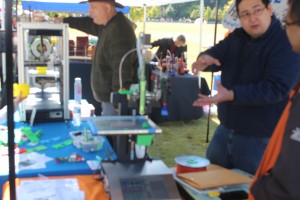The newest frontier in library service is the development of a MakerSpace, which can include access to 3D technology. Mick Ebeling at Not Impossible Labs provides an inspiring example of how 3D printers can make a difference in the world.
Why should the Library offer a MakerSpace environment? According to Mick, its time to start planning for the impossible – the future!
The library is an ideal place to introduce people to 3D technology. By providing computers and software to work on 3D projects, as well as a place to print these new creations, the library can help people step into a new world. They can be the “go-to” place for their students and patrons by enabling them to send the file(s) they want printed. The library will provide a time/cost estimate and print the items for pickup. See 3D rose example
As with any transition, libraries and educators need to be prepared before they offer such a service.There are few things more frustrating to patrons than seeing a service offered that then can’t be delivered! To avoid this, look for 3D printers that don’t require a lot of maintenance, and make sure staff have the technical training to manage the equipment, enabling them to share “making” skills with the community. For example, what will you do if you need to “level the build plate” or get help when the machine gets stuck? Investing in the necessary training for staff is essential; in a digital world, the library staff is actually more important than ever.
The Library MakerSpace will take a lot of work from the community to get started. The library staff will need to develop policies and procedures for MakerSpace services and equipment. For example, if you want to allow people use to hands-on tools you will need to provide space to work and a reasonable length of time to do so. This requires user policies, plans for time limits, and more.
How does the 3D printer work?
The 3D printer system works like an automated cake maker; cold plastic is loaded into the machine and fed through a tube that is heated. The liquidized plastic is pushed through a tube like a decorator that writes “happy birthday” on a cake. This is a simplistic description that can be expanded to incorporate metal, wood and biodegradable plastic printing.
Product Ideas
The costs for entry into 3D library makerspaces is roughly $1,500 to $2,500 depending on the Makerbot Replicator. It comes with software that makes it possible to develop objects. Other manufacturers are Polyprinter and Lulzbot Mini. In addition, Lulzbot and Cura is a good hardware / software combination. Download Cura – free 3D software.
Software Ideas
Software is an important part of the 3D printing experience. AutoCAD works very well with the 3D printer. However, there are other open source options – Meshmixer, Tinkercad, Cura and/or AutoDesk 123D. This software needs to be intuitive and easy to work with and designed specifically to produce 3D-printable model files.
Once your library is also a makerspace, you may be able to connect your library to other MakerSpaces. Go to Skyforge and check out this service; it links all of the 3D printers together.



